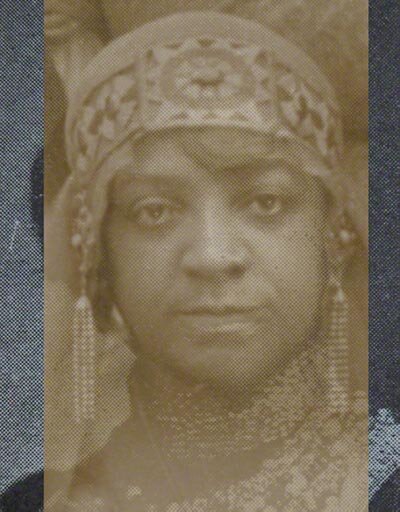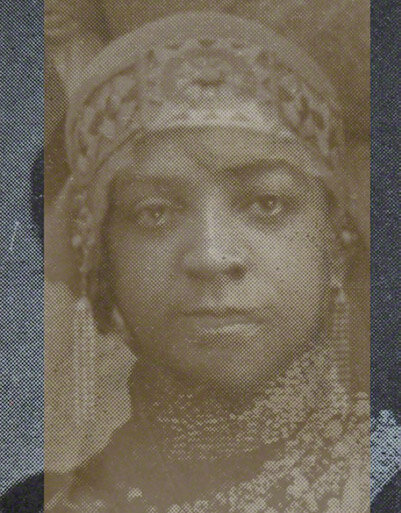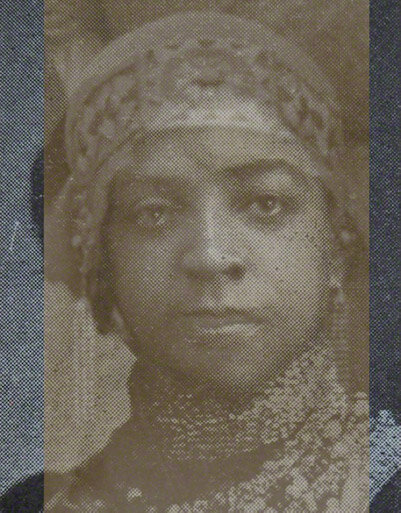Primary Sources 2:
The Hindoo Dance of Death
1898 was a big year for Walter Brister. He was still on the road with the show In Old Kentucky and moved with his father from Cincinnati to Covington, KY and back to Cincinnati between 1897 and 1903. Sometime in the 1890s, Walter’s parents marriage broke up and his father remarried Grace. Walter played in the Kentucky “pickaninny” band in January of 1897. But he also began a new role, that of Armmah Sotanki, a Hindoo Wonder Worker, and gave his first performance May 14, 1898 at Wonderland in New York City. By Thanksgiving he brought the act to Cincinnati alongside a companion “Armatoo” and an entire company of “Hindoo jugglers, fakirs, and wonder workers.” Not only did Sotanki present himself as a religious figure, but his ads promised that his act could not be explained except through the teachings of Theosophy.
Also in 1898, his future wife and a woman who was likely already a member of his Sotanki troupe, Eva Alexander, married another man, James Hammond, in New York City. Though only 23, this was Eva’s second marriage; her first ended in divorce.
In 1899, Brister joined the Pawnee Bill Wild West Show for the first time.
Eva’s second marriage didn’t last either. Hammond died, and Eva Alexander Hammond married Walter Brister in the city they both called home, Cincinnati, in 1900. He still listed his occupation as musician, but she listed hers as magician.
The couple was married in the middle of the Sotankis’ tour with the Pawnee Bill Wild West Show. Their pictures and names appeared in the 1900 route book.
The following year, the Pawnee Bill Route Book identified Arrmah Sotanki as Walter Brister. In 1903 the couple used the same pictures with the John Robinson Circus, and Eva is identified as a Hindoo Lion tamer— the first Black woman lion tamer, after only perhaps 3 Black men (see gallery page). The couple survived a direct hit by a tornado on the circus tent that blew a chandelier into the canvas and ignited a massive fire. Amazingly, no one was killed. The couple also travelled to France and Germany in 1905, where a Parisian photographer took pictures of Eva in the classic pose of the odalisque, with an Arabian hooka, or water pipe.
Researchers Fathie Ali Abdat and Patrick Bowen have established that in time as “Professor Drew the Egyptian Adept” and as an organizer of the Canaanite Temple in Newark, New Jersey from 1913 until the early 1920s, Noble Drew Ali used the name “Thomas Drew,” not Timothy Drew as has often been reported. In 1900 Thomas Drew was living with his ADOPTED father James Drew and his mother— LUCY. I have not yet found a marriage certificate that would establish definitively whether this was Lucy Conway (spelling ?) Brister—the place to look would be local historical societies in Norfolk, VA— but the timing would fit with the fact that John Henry Brister married Grace sometime between 1880 and 1903.
See Thomas Drew, line 18. Note that he is listed as adopted: “adpt son” born 1886. Most of the 1890 census was destroyed by fire, so we can’t find Thomas in the 1890 census, when he would have four years old and likely living in Carlisle, KY with Lucy and John Brister.
The fame of the Sotanki troupe continued to grow, and Princess Sotanki became the headliner, rather than her husband. In 1906 he started living in Chicago, though in 1905 and 1909 he listed his address in Cincinnati. In 1912 he played in the show Southland at Chicago’s Grand Theater, under the direction of the great Joe Jordan.
But it appears that the demands of the road and perhaps other factors took a toll on the Bristers’ marriage; for at least some of the years between 1905 and 1913 we can see that they were living apart. Princess Sotanki managed a vaudeville theater in Paducah, Kentucky whereas Walter was between Cincinnati and Chicago. Then in 1912 and 1914 two curious stories appeared in the Black press. The first, on November 30, 1912, announced “This will be [the] last week of the princess' stage career, as she will retire for life. She is the prospective bride of a successful magnate of Ashbury Park, N.J. We will see the little princess in the future assisting in managing business affairs in the interest of her husband's enterprise, as her past stage career will be of great benefit to him.” - George Slaughter, "Louisville, Kentucky" Indianapolis Freeman (Nov 30, 1912): 4. The problem is, Eva Brister was still married to Walter. Why would she be heading to Asbury Park, a seaside town with sideshow complex, close to Newark, NJ?
It is said that Thomas (or Timothy) Drew started the Canaanite Temple in Newark, NJ in 1913, although I have not seen any written documentation of that date. The tale takes another twist however in 1914, when the same newspaper reported that Princess Sotanki rushed to her husband Walter Brister’s bedside and nursed him until he died.
As you will see below, I knew that Walter Brister survived. So at first I thought that this story was just a spoof. But I found a death certificate for Walter Brister signed death certificate and when I telephoned the cemetery they gave me the name of the undertaker who signed the burial certificate. So the Bristers produced a body and put it into the ground. Whose?
How could the same newspaper who reported that Princess Sotanki was marrying someone else Nov 30, 1912 report that she rushed to her husband Walter Brister’s side only 17 months later? One answer is that the Indianapolis Freeman was the journal of record for Black performers, who frequently used it to send messages to each other. Usually these were innocuous greetings. But in this case, the reporter for the Freeman seems to have been in on the scheme. Friends who knew the Sotankis would have had to know that one or both of these stories was false— they couldn’t both be true. Indeed, the message-bearing quality of the Freeman’s entertainment page was demonstrated soon thereafter when George Barrett, a veteran performer, sent regards to Princess Sotanki and said “Hello, Drew, look out for Ali Mona, he’s got some juggling act.”
As I discuss in my book, “juggling” was synonymous with Oriental magic, and “Hindu” fakirs like the Sotankis were often known as jugglers. This newspaper indicates that there was someone known as Drew in Sotanki’s troupe. Since scholars Bowen and Abdat have established that Thomas Drew/Professor Drew became Noble Drew Ali, and since both Walter Brister and Thomas Drew had a mother named Lucy (not a common name), the simplest explanation is that Walter and Thomas were brothers. The Bristers may have buried Thomas in Chicago in 1914, and Walter moved to Newark, and continued performing at times with Princess Sotanki, as Thomas Drew. This, however, is speculation and would take genetic testing of Walter’s remains to confirm or the discovery of a marriage certificate for James and Lucy Drew.
We know however that Walter and Eva dissolved their marriage, perhaps as part of the pact for her helping him to fake his death, because she remarried in 1919. As Family Search reports from digitized marriage records from Ohio:
Name: Eva Brister [Eva Alexander] Gender: Female Age: 43 Birth Date: abt 1876 Marriage Date: 7 Jul 1919 Marriage Place: Hamilton , Ohio , USA Father: Arthur Alexander Mother: Rebecca Garrett Spouse: Adam Allen. Film Number: 000384164
Eva and Adam Allen turn up in the 1920 Census living together in Cincinnati when Eva was 44, though by the 1930 Census Eva Allen was widowed. In other words, Eva Alexander was married four times: Unknown, James Hammond, Walter Brister, Adam Allen. Three of those husbands died a total of four times. (!)
So that brings us back to the most famous picture of the Moorish Science Temple of America, and the enigmatic couple at the center of the photo. Take a closer look. Do they look familiar?
When you ask most Moors who is the woman seated next to the prophet, most think she is the wife of Sheik James Lomax Bey from Detroit, standing on her other side. But upon closer examination, it is clear that the woman is Eva Allen, formerly Eva Brister. (The 1920 census shows Lomax Bey married to someone else.) The photos were taken 28 years apart, so her face shows the standard signs of aging, including growth of the soft tissue of the nose, loss of collagen in the lips, fattening of the jowls and sagging of the eyes. For a scientific study of aging on the face, see this article. For an article on age-related changes in the nose specifically, see this article. But when you overlay the two photos, the geometry of the eyes, nose, and mouth match exactly.
1900 1928
In fact, you can make an animation that shows this.






The photos of Noble Drew Ali and Walter Brister are harder to match because none are at the exact same angle. But notice the prominent mole on the right side of Noble Drew Ali’s nose.
The same mole is clearly visible in other photographs of Noble Drew Ali from the late 1920s, such as this one from the collection of the Schomburg Center of the New York Public Library:
So the question is, if we return to the photo that Walter Brister used from 1900-1903, can we see a mole in the same place, on the right side of his nose? See for yourself. Your ability to see a dot formed out of other dots depends on your distance from the image. So try zooming in and out, (command and + or -). On my laptop it’s actually easiest to see the mole at a screen resolution of 50%. You can now find this same image in Illinois State University’s online archive of circus route books; see Pawnee Bill’s Wild West Show, years 1899, 1900 & 1901.
Q.E.D.
Prophet Noble Drew Ali was born John Walter Brister around 1879.
He was the first Black child star on Broadway, the star of the show that became the most popular American play ever by WWI.
He participated in the Princeton Riot in 1899, and translated the cosmopolitanism of the circus and Wild West Show into a anti-racist and anti-racialist religion that incorporated the Native American Ghost Dance and the Islam of his co-workers, the Ali Brothers.
He performed as Armmah Sotanki along with his wife, Eva Alexander Hammond Brister, who took the name Eva Allen after she helped him to fake his death in 1914.
As the leader of the Moors, Noble Drew Ali founded the first Muslim mass movement in America, with estimated membership of between 7-15,000 members.
He founded many profitable businesses that generated millions in income in today’s dollars.
He also helped to swing elections in Illinois and to attract many of Chicago’s most prominent Black citizens.
But the elites wanted more. When they tried to muscle in on the Moors, and backed the business manager Claude Greene in a takeover attempt, Greene was murdered by members of the Moorish Science Temple of America in Unity Hall.
But unbeknownst to the Moors, the man who had purchased Unity Hall was Samuel Insull, the most powerful business racketeer in America and one of the chief financial backers of “America First” Mayor “Big Bill” Thompson.
Another of Thompson’s shadow backers was Al Capone and his partners: Jack Guzick, Ralph Capone, and Frank Nitti.
The murder of Claude Greene threatened to bring attention to Insull’s backing of Congressman-elect Oscar DePriest, who was already under indictment for political corruption.
Noble Drew Ali’s death several months later was only one of a handful of deaths of Black political figures who bucked Thompson and allied with the rival machine of Senator Charles Deneen.
With Noble Drew Ali’s death, allegedly of tuberculosis, on July 20, 1929, and the flight of Detroit MSTA head James Lomax-Bey, who feared for his life, two new figures emerged from the MSTA in Detroit and organized a new group that would become more famous, if not more impactful: the Nation of Islam. After some years in Egypt, Lomax-Bey returned to the states and founded many Sunni Muslim groups. So virtually ALL African American Muslim groups today, in one way or another, owe their genesis to one man: the prophet Noble Drew Ali, who worked literally alongside his former wife, Eva Alexander Hammond Brister Allen, aka Princess Sotanki.
And Lastly…
Finally, some reviewers have blamed me for not judging Walter Brister and not condemning him an imposter and a conman. I find this charge ridiculous and possibly racist. When historians write about white characters who change and shed identities, they do not customarily also judge them for doing so. The great Natalie Zemon Davis never judged Arnaud du Tilh for pretending to be Martin Guerre and >clutch pearls< sleeping with his wife. I trust my readers to make their own moral judgments for themselves.
Meanwhile, such calls to condemn my protagonist overlook the historical context of vicious white supremacy that he faced. In Islam, Walter Brister found an escape hatch in the iron cage of American white supremacist racism, just as surely as Hindoo magicians like Harry Houdini escaped from their cabinet mysteries. Yes, all scholars agree that Moors originated in and influenced West Africa and that there were thousands Muslims among the thousands of Africans enslaved in the Americas. So Noble Drew Ali’s teaching that African Americans are not “Negroes” but Moors and Muslims was infinitely more true than the entirely false and racist canard that Black people were not even fully human— which was not fringe belief but was widely disseminated in his lifetime in circuses and colleges alike.
I also believe that knowing Noble Drew Ali’s backstory takes nothing away from his accomplishments. Rather, the story of transformation it holds makes him more relatable. He was human. He struggled. He suffered arrests. He apparently even escaped death and remade himself. What greater transformation could there be than that? A large part of Malcolm X’s appeal comes from the fact that he transformed himself from a gangster to a man of God. Knowing that Noble Drew Ali had an amazingly varied and colorful life before emerging as a prophet in 1925 helps us to understand him and relate to him all the more. Knowing that Jesus was once a carpenter doesn’t change one’s opinion of his divinity or the wisdom of his teachings.
So, yes, I think that Walter Brister, aka Prophet Noble Drew Ali, was a genius. That does not mean I have “fallen in love” with him. That means that I appreciate the magnitude of his accomplishment, and his outsized impact on America, as an entertainer, as a political operative, as a businessman, and most of all as a Muslim leader and visionary who made Islam widely appealing to thousands of African Americans for the first time in the twentieth century.
What do YOU think? I’m eager to hear from you, especially if you have thoughts after reading the book. Please contact me.
And as the Prophet Noble Drew Ali said,
PEACE.
Jacob S. Dorman, Ph.D.






